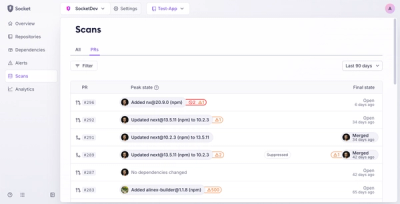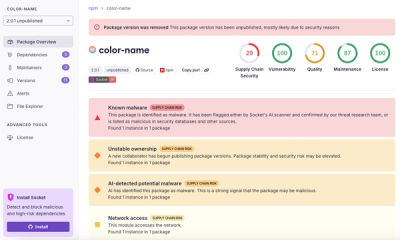
Product
Introducing Pull Request Stories to Help Security Teams Track Supply Chain Risks
Socket’s new Pull Request Stories give security teams clear visibility into dependency risks and outcomes across scanned pull requests.
seneca-user
Advanced tools

A Seneca.js User Management Plugin
Lead Maintainers: Mircea Alexandru and Mihai Dima
This module is a plugin for the Seneca framework. It provides business logic for user management, such as:
This plugin needs seneca-basic and seneca-entity plugins to function properly.
There are two core concepts: user and login. A user, storing the user account details and encrypted passwords, and a login, representing an instance of a user that has been authenticated. A user can have multiple logins.
This module does not make any assumptions about the context it runs in. Use the seneca-auth plugin to handle web and social media authentication.
For a working example, see the Seneca user accounts example
If you're using this module, feel free to contact me on Twitter if you have any questions! :) @rjrodger
For code samples, please see the tests for this plugin.
Supports Seneca versions 1.x - 3.x
npm install seneca
npm install seneca-user
You'll need the seneca module to use this module - it's just a plugin.
var seneca = require('seneca')()
seneca.use(require('seneca-basic'))
seneca.use(require('seneca-entity'))
seneca.use(require('seneca-user'))
seneca.ready(function (){
seneca.act( {role: 'user', cmd: 'register', name: "Flann O'Brien", email: 'nincompoop@deselby.com', password: 'blackair'},
function (err, out) {
seneca.act({role: 'user', cmd: 'login', email: 'nincompoop@deselby.com', password: 'bicycle'}, function (err, out) {
console.log('login success: ' + out.ok)
seneca.act({role: 'user', cmd: 'login', email: 'nincompoop@deselby.com', password: 'blackair'}, function (err,out) {
console.log('login success: ' + out.ok)
console.log('login instance: ' + out.login)
})
})
})
})
In the example code, a user is registered, and then two login attempts are made. The first with an incorrect password, the second with the correct
password. The successful login provides a login instance. The login.id property can be used to authenticate this login. For example,
the seneca-auth plugin uses this token as a HTTP authentication cookie.
To run this example (and the other code in this README), try:
node test/readme.js
Take a look at the user accounts example.
To load the plugin:
seneca.use('user', { ... options ... })
The user and login data is persisted using Seneca entities. These have
names sys/user and sys/login.
Passwords are not stored in plaintext, but using an ~10k round salted SHA512 hash. In the context of password reset functionality, this means you can generate new passwords, but cannot recover old ones. This is what you want.
There are separate actions to encrypt and verify passwords, so you can do things your own way if you like.
To support different use cases, users can be identified by either a
nick or their email address. The nick property is the traditional
'username', but does not need to be used in this fashion (hence the name 'nick').
All actions defined by this plugin return meta data objects containing the results of the action. The meta data object
contains an ok field that is either true or false, indicating the success or failure of the action. For example, a login attempt with an invalid password will result in an {ok:false,...}. When relevant, a why property is also provided, with a code that indicates the reason for the result. For example: {...,why:'user-not-found'}.
rounds: number of SHA512 rounds to use for password encryption, default: 11111autopass: automatically generate an (unrecoverable) password if none is supplied - mostly good for testing, default: truemustrepeat: you must provide a repeat argument (a repeat of the password) when setting a passwordresetperiod: duration in millis that a password reset token is valid, default: 24 hourspepper: used in addition to password salts, a pepper is very similar but is stored in code instead of a database.failedCount: number of failed attempts before the account is locked. Disabled by default.To set options, do so when you load the plugin:
seneca.use('user', { resetperiod: 3600*1000 })
The user entity has a default type of -/sys/user and standard properties:
nick: Username, mostly. If not provided, will be set to email value.email: Email address. At least one of nick or email is required.name: Name of user. Just a text field. Cultural imperialism damages your conversions, ya know...!active: if true, user can log in, if false, user can't. Default: true.when: creation time, ISO String, like 2013-03-21T17:32:24.039Zsalt: salt for encrypted passwordpass: encrypted passwordYou can add your own properties, but be careful not to use the standard property names.
The login entity has a default type of -/sys/login and standard properties:
id: authentication token, UUIDnick: copied from useruser: user.id stringwhen: creation time, ISO String, like 2013-03-21T17:32:24.039Zactive: if true, login against this token will succeed, otherwise notYou can add your own properties, but be careful not to use the standard property names.
The reset entity has a default type of -/sys/reset and standard properties:
id: authentication token, UUIDnick: copied from useruser: user.id stringwhen: creation time, ISO String, like 2013-03-21T17:32:24.039Zactive: if true, reset against this token will succeed, otherwise notYou can add your own properties, but be careful not to use the standard property names.
All actions provide results via the standard callback format: function(error,data){ ... }.
To customize the behavior of the plugin, override these actions, and provide your own business logic. You can call this.prior
inside each custom action to perform the default behaviour - see the [Customization] section below.
Login an existing user. Creates a new sys_login entry.
nick: required if no email, identifies user, alias: usernameemail: required if no nick, identifies userpassword: password as entered by user, optional if using _autoauto: automatic login without password, default: false. Use this to generate login tokens.user: specify user using a sys/user entity - for convenience use inside your own actions, when you already have a user entity loadedObject with properties:
login: login entity, id is the login token, used as cookiewhy: indicates reason login failed or succeeded, refer to source for codes.Logout a user. Update sys/login entry to active:false. Adds ended field with ISOString date time.
token: existing login token, maybe from a cookieSame object format as login command result: {ok:true|false,user:,login:}
Register a new user. You'll probably call this after a user fills out a regstration form. Any additional action arguments are saved as user properties. The nick and email fields will be checked for uniqueness. The new user is not logged in, use the login action for that.
nick: Username, mostly. If not provided, will be set to args.username value, if defined, otherwise args.email valueemail: Email address. At least one of nick or email is requiredusername: a convenience - just an alias for nickpassword: Plaintext password, supplied by user - will be stored encrypted and unrecoverablerepeat: Password, repeated. Optional - if provided, must match passwordname: Name of user. Just a text field.active: if true, user can log in, if false, user can't. Default: trueObject with properties:
ok: true if registration succeeded, false if nouser: new user entitywhy: indicates reason registration failed, refer to source for codes`Authenticate a login token, returning the associated sys/login and sys/user if
the token is valid and active. Use this, for example, when handling
HTTP requests with an authentication cookie, to get the user.
token: existing login token, maybe from a cookieSame object format as login command result: {ok:true|false,user:,login:}
Create a reset token, valid for a 24 hours (use the resetperiod options to alter the validity period). This action
creates an entry in the sys/reset collection.
nick: required if no email, identifies user, alias: usernameemail: required if no nick, identifies useruser: specify user using a sys/user entity - for convenience use inside your own actions, when you already have a user entity loadedObject with properties:
ok: true if update succeeded, false if notuser: sys/user entityreset: sys/reset entityLoad a sys/reset entity using a reset token. Use this to load the details of a reset request, possible to confirm with user.
token: reset tokenObject with properties:
ok: true if reset found, false if notuser: sys/user entityreset: sys/reset entitywhy: reason for failureExecute a password reset action. The user identified by the reset token is allowed to change their password. THe reset must be active, and the validity period must not be expired. On successful reset, the sys/reset is deactivated and cannot be reused.
token: reset tokenpassword: new passwordrepeat: optional, repeat of new passwordObject with properties:
ok: true if reset found, false if notuser: sys/user entityreset: sys/reset entitywhy: reason for failureEncrypts a plaintext password, providing the salt and ciphertext. The encyption is options.rounds (default:11111) rounds of SHA512.
password: plaintext password.repeat: optional, repeat of passwordObject with properties:
ok: true if succeededsalt: the salt stringpass: the ciphertext stringwhy: reason for failureVerifies that a password matches a given salt and ciphertext.
salt: the salt string to use, find this in user.saltpass: the pass string to use, find this in user.passproposed: the proposed plaintext password to verifyObject with properties:
ok: true if password matchesUpdates a user.
nick: the nick of the user to be updatedorig_nick: if nick will be changed on this update then orig_nick will be used to identify the useremail: the email of the user to be updatedorig_email: if email will be changed on this update then orig_email will be used to identify the userAt least one of these arguments must be present.
Object with properties:
ok: true if operation is OKDeletes an user and all relationed records.
nick: the nick of the user to be updatedObject with properties:
ok: true if operation is OKEnables an user.
nick: the nick of the user to be updatedemail: the email of the user to be updatedAt least one of these arguments must be present
Object with properties:
ok: true if operation is OKDisables an user.
nick: the nick of the user to be updatedemail: the email of the user to be updatedAt least one of these arguments must be present
Object with properties:
ok: true if operation is OKRemoves the lock form a user account
id: the id of the userok: true if the account was unlockedTo see what this plugin is doing, try:
node your-app.js --seneca.log=plugin:user
This will print action logs and plugin logs for the user plugin. To skip the action logs, use:
node your-app.js --seneca.log=type:plugin,plugin:user
You can also set up the logging programmatically:
var seneca = require('seneca')({
log:{
map:[
{plugin:'user',handler:'print'}
]
}
})
For more on logging, see the seneca logging example.
As with all seneca plugins, you can customize behavior simply by overwriting actions.
For example, to add some custom fields when registering a user:
// override by using the same action pattern
seneca.add({role:' user', cmd: 'register'},function (args, done) {
// assign user to one of 10 random "teams"
args.team = Math.floor(10 * Math.random())
// this calls the original action, as provided by the user plugin
this.prior(args,done)
})
userpin.register({name: "Brian O'Nolan", email: 'brian@swim-two-birds.com', password: 'na-gCopaleen'},
function (err, out) {
console.log('user has team: ' + out.user.team)
})
The Senecajs org encourages open participation. If you feel you can help in any way, be it with documentation, examples, extra testing, or new features please get in touch.
npm test
Copyright (c) 2012-2016, Richard Rodger and other contributors. Licensed under MIT.
FAQs
User management plugin for Seneca
We found that seneca-user demonstrated a not healthy version release cadence and project activity because the last version was released a year ago. It has 2 open source maintainers collaborating on the project.
Did you know?

Socket for GitHub automatically highlights issues in each pull request and monitors the health of all your open source dependencies. Discover the contents of your packages and block harmful activity before you install or update your dependencies.

Product
Socket’s new Pull Request Stories give security teams clear visibility into dependency risks and outcomes across scanned pull requests.

Research
/Security News
npm author Qix’s account was compromised, with malicious versions of popular packages like chalk-template, color-convert, and strip-ansi published.

Research
Four npm packages disguised as cryptographic tools steal developer credentials and send them to attacker-controlled Telegram infrastructure.